
* After World War II, the US Army fielded America's first SAM, the "Nike Ajax", which led to the more powerful "Nike Hercules", as well as as largely experimental anti-ballistic missile (ABM) interceptors. Roughly in parallel with Nike Ajax development, the US Air Force developed a long-range ramjet-powered SAM, the "BOMARC", while the Army also developed a tactical SAM, the "Hawk".
* Although the US had lagged the Germans in the development of guided weapons during World War II, after the war the American military decided to put some of the information they had learned during the war to good use.
In 1945, the US Army issued contracts to Bell Telephone Laboratories and Western Electric for studies on an "Anti-Aircraft Guided Missile (AAGM)", or "surface-to-air missile (SAM)" in modern terms, that could shoot down high-flying bombers. The studies led to a development contract, with Western Electric as the prime contractor and Douglas Aircraft responsible for the missile airframe. The first test firing of the "SAM-A-7 Nike 1", as it was originally designated, was at the White Sands, New Mexico, missile range in 1951, and the weapon entered US Army service in December 1953, to become the "Nike Ajax". It was the first guided missile in full US operational service.
The Nike Ajax was a two-stage weapon, with a first stage featuring three fins, and a dartlike second stage with cruciform fins on the nose plus larger cruciform wings on the rear. The first stage was built around a Goodyear solid-propellant rocket that generated 262.5 kN (26,760 kgp / 59,000 lbf) of thrust for 2.5 seconds; it was derived from the booster developed by the Navy's Project BUMBLEBEE, which would lead to the Talos naval SAM, discussed later. The second stage was powered by a liquid-fuel Aerojet General rocket motor using storable propellants, with JP4 (aviation-grade kerosene) fuel and nitric acid oxidizer, and providing 11.6 kN (1,180 kgp / 2,600 lbf) of thrust for 30 seconds. It carried a proximity-fuzed blast-fragmentation warhead.
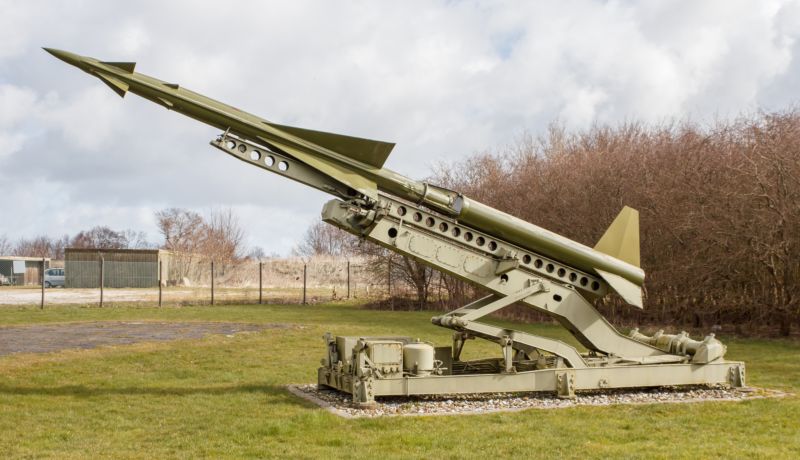
The Nike Ajax was launched from a near-vertical position on an erector-launcher. A "Low-Power Acquisition Radar (LOPAR)" searched for targets, with an associated interrogation friend or foe (IFF) unit determining if the target was friendly or hostile. If a target was selected, a "target-tracking radar (TTR)" locked on to the target. On launch, the Nike Ajax was followed by a "Missile Tracking Radar (MTR)", with the MTR and TTR feeding information to an analog computer that radioed course corrections to the missile. The analog computer determined when the missile would detonate its warheads.
_______________________________________________________________
NIKE AJAX:
_______________________________________________________________
wingspan:
1.6 meters (5 feet 3 inches)
length:
10.8 meters (35 feet 6 inches)
diameter:
30 centimeters (1 foot)
launch weight:
1,115 kilograms (2,455 pounds)
warhead weight:
135 kilograms (300 pounds)
speed:
Mach 2.25
ceiling:
19 kilometers (62,000 feet)
range:
40 kilometers (25 MI / 22 NMI)
_______________________________________________________________
A Nike Ajax battalion, with a staff of 400 men, included four batteries. Each battery had twelve launchers and associated guidance equipment with each battery. The entire system could be broken down, loaded on trailers, and transported by air. Small fixed sites were also built, typically with four launchers, two underground magazines, and a control center with radars and the guidance link. The launch area and the control area were separate, primarily because a missile launch would confuse the radars if it took place right next to them.
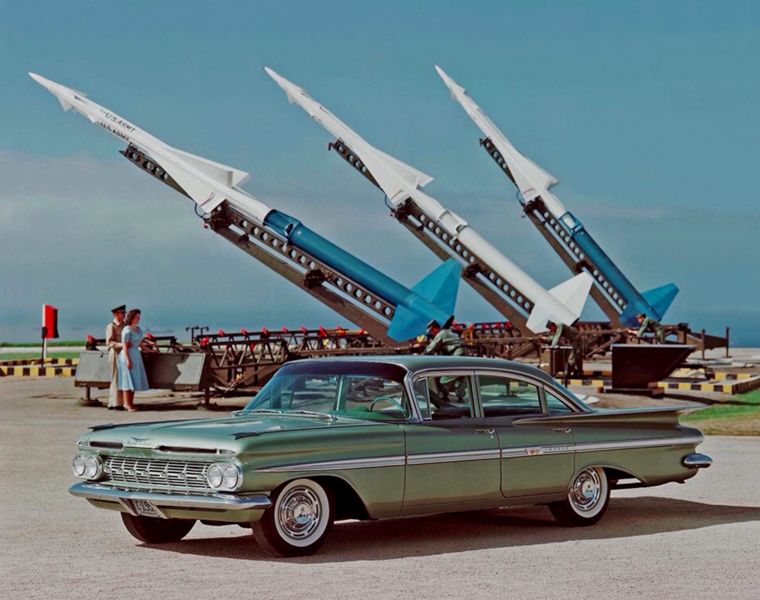
The biggest problem of the Nike Ajax was that a battery could only engage one target at a time. Worse, at the outset the batteries weren't very well linked with each other, and multiple batteries couldn't coordinate their fire. Eventually, the USAF developed the "Semi-Automated Ground Environment (SAGE)" system, with control centers that could coordinate air-defense assets by a region.
Over 10,000 Nike Ajax missiles were built by 1958, when the weapon was replaced by the improved Nike Hercules. When the Pentagon adopted a uniform designation scheme in 1962, the Nike Ajax was redesignated "Mobile Interceptor Missile (MIM) 3". At its peak in 1958, the Nike Ajax equipped 60 US Army missile battalions in the US. It was also used by NATO and sold to the Japanese.

The Nike Ajax was phased out in the early 1960s. After being phased out, however, the solid-rocket boosters were "recycled" for launching sounding rockets, with a series of Nike / sounding rocket combos such as "Nike Cajun", "Nike Deacon", "Nike Apache", and "Nike Tomahawk". The combos remained in use for decades -- and being simple in configuration, provided inspiration for flightworthy model rockets.
BACK_TO_TOP* Even as the Nike Ajax was entering service in 1953, the US Army was issuing contracts for its successor, originally designated "Nike B". The new SAM began to enter service in 1958 as the "MIM-14 Nike Hercules", and would completely replace the Nike Ajax in five years.
The Nike Hercules was about four times bigger and was much more powerful than the Nike Ajax. It was launched by a solid-rocket booster stage with four fins that was essentially a cluster of four Nike Ajax solid-rocket boosters. The second stage was also powered by a solid rocket, using a Thiokol M112 engine, instead of troublesome storable liquid propellants. The second stage could be fitted with either a conventional or, more generally, a kiloton-range nuclear warhead.
_______________________________________________________________
NIKE HERCULES:
_______________________________________________________________
wingspan:
2.13 meters (7 feet)
length:
12.65 meters (41 feet 6 inches)
diameter:
80 centimeters (2 feet 7 inches)
launch weight:
4,720 kilograms (10,400 pounds)
speed:
Mach 3.5
min ceiling:
6,000 meters (20,000 feet)
max ceiling:
30,000 meters (100,000 feet)
min range:
30 kilometers (19 MI / 16 NMI)
max range:
130 kilometers (80 MI / 70 NMI)
_______________________________________________________________
A Nike Hercules site was much like a Nike Ajax site, with the Nike Ajax sites upgraded to handle the Nike Hercules. The Nike Ajax control systems were retained, but a high-power acquisition radar (HIPAR) was added to accommodate the longer range of the Nike Hercules, while a target ranging radar (TRR) was added to help defeat countermeasures. Intercepts were still controlled by an analog computer, but it was upgraded to a digital computer later in the missile's service life. Like the Nike Ajax, a Nike Hercules battery could only engage one target at a time, but SAGE could coordinate multiple batteries -- when it was working right, the system being very complicated and unreliable, being based on the biggest vacuum-tube computers ever made. Those computers were, however, vastly less powerful than a cheap modern smartphone.
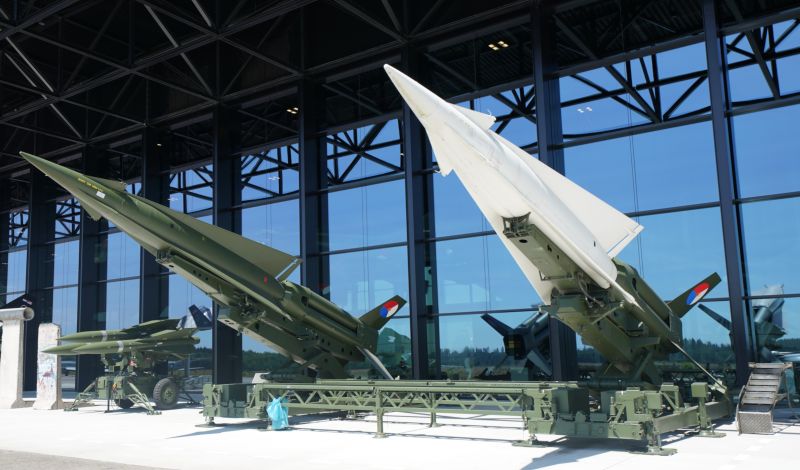
At its peak, in 1963, the Nike Hercules equipped 134 batteries in the United States, but by that time the Soviet bomber threat was beginning to recede, and in the 1970s US-based SAM sites were shut down. The Nike Hercules remained in US service overseas into the early 1980s, and lingered in NATO and Japanese service for some years after that. It was generally replaced by the Raytheon Patriot, discussed later. The Nike Hercules successfully intercepted short-range ballistic missiles (SRBM) in tests, though under highly controlled conditions, and was also used experimentally in the surface-to-surface role.
BACK_TO_TOP* After World War II, the US Army sponsored the first studies on how to intercept ballistic missiles such as the German V-2s that had been fired on London. The studies, codenamed THUMPER and WIZARD, concluded that interceptor missiles or, more speculatively, "directed-energy" weapons such as particle or microwave beams, might be able to shoot down an incoming missile.
In 1956, at about the time of the fielding of the first long-range ballistic missiles, the US Army initiated development of an anti-ballistic missile (ABM) system that would become known as "Nike Zeus". Bell Laboratories was in charge of design and development, while Bell's Western Electric was the prime contractor for the Army. Douglas designed the missile element of the system, the two-stage "Zeus" missile, derived from the Nike Hercules anti-aircraft missile then going into Army service.

The Zeus missile was only part of a highly complex system. The Ballistic Missile Early Warning System (BMEWS) -- a network of radar stations in the north -- would indicate an attack in progress. Once the ABM system was activated, the long-range "Zeus Acquisition Radar (ZAR)" would pick up incoming "re-entry vehicles (RV)", warheads, from a range of 2,400 kilometers (1,500 miles). ZAR provided advance warning and location of the region under attack. Following acquisition by ZAR, the incoming warheads were then targeted by "Discrimination Radars (DR)" at the missile launch sites, which sorted out which of the targets were really warheads and which were decoys or junk left over from the booster. Once the real warheads were identified, "Target Tracking Radars (TTR)" then locked onto them, and the Zeus missiles were launched from underground silos.
The Zeus missiles were guided to their targets by "Missile Track Radars (MTRs)", with course corrections transmitted by radio. The Zeus missile released what would now be called a "kill vehicle" as it approached a target RV at an altitude of 320 to 400 kilometers (220 to 250 miles). The kill vehicle was a maneuverable nuclear warhead with a yield in the megaton range that detonated when it came near to the incoming RV, or on command from the ground. The Zeus kill vehicle only had to come within a few kilometers of an incoming RV to "kill" it with its own warhead.
Nike Zeus was designed to protect large urban areas, not military targets. The initial system, which was to provide cover for a limited number of cities, was projected to consist of 69 batteries with 50 missiles each, at a total cost of $10 billion USD in contemporary dollar values. An expanded system with 120 batteries was expected to cost $15 billion USD.
* Elements of the Nike Zeus were completed and performed impressive feats in tests, with an initial successful interception of an Atlas ICBM RV in July 1962, subsequent interceptions of other Atlas and Titan I RVs, and a successful interception of a satellite in October 1963. However, the tests clearly showed that Nike Zeus was not a practical system. The radars were all mechanically directed, and so tracking a large number of separate targets was impractical. The ability to discriminate between decoys and an actual RV was very poor. The Zeus missile could only engage RVs before they entered the atmosphere.
Work on a new system named "Nike X" was begun in the 1960s in hopes of resolving these difficulties. This involved new fast-scanning, electronically-steered "phased array" radars, including the long-range "Multifunction Array Radar (MAR)" and the short-range "Missile Site Radar (MSR)". Development work was begun by Martin in 1962 for a short-range missile named "Sprint", and in 1965 Douglas was awarded a contract to update the Zeus.
The Zeus was given a third stage and updated subsystems, to be renamed "Spartan". Spartan was a solid-fuel missile, 16.8 meters (55 feet) long, with a launch weight of 13,015 kilograms (28,700 pounds) and a range of about 750 kilometers (465 miles). It had a warhead with megaton yield plus enhanced X-ray production, improving its ability to "fry" RVs moving through space.

The short-range Sprint was a single-stage solid-fuel missile, in the form of a tall narrow cone, with a length of 8.23 meters (27 feet), a launch weight of 3,400 kilograms (7,500 pounds), and a range of 40 kilometers (25 miles). The missile had a fast-burn propellant that gave it an astounding acceleration of 100 gees, and had a skin covered with a silica phenolic matrix ablative materials to withstand intense friction. Sprint's control electronics were radiation-hardened to function through a nuclear explosion, and the communications link had to be able to penetrate the envelope of ionized gases that surrounded the streaking missile in flight. The Sprint was armed with a nuclear warhead in the low kiloton range. The first Sprint firing took place in 1965, with the first successful intercept of an RV, launched by a Minuteman ICBM, in December 1970. The missile was directed by an MSR, which also commanded the Sprint to detonate its warhead.
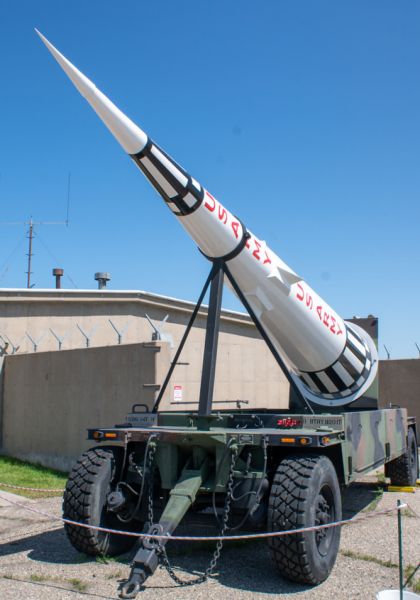
* In 1967, faced with Soviet refusal to discuss arms limitations on ABM systems, US President Lyndon Johnson decided to go ahead with deployment of the Sprint-Spartan system, which was given the overall name of "Sentinel". Sentinel was regarded as a limited defensive system, able to defend against attacks from a relatively unsophisticated adversary such as Red China, but not an all-out attack by the Soviet Union.
In 1969, US President Richard Nixon refocused Sentinel to protect US ballistic missile sites from a Soviet pre-emptive strike. The system was renamed "Safeguard". In principle, Safeguard could be expanded to provide a defense from Red Chinese missiles, though again no one seriously considered that it could stop an all-out attack by the USSR.
Technology development continued on a relatively straight path during these changes in mission definition. The first Spartan missile was delivered in 1968, and performed its first successful intercept of a re-entry vehicle, launched by a Minuteman ICBM, in August 1970. A double intercept was performed in January 1971, and later in that year a Spartan successfully intercepted a warhead launched by a Polaris missile along with decoys and other penetration aids.
* The Soviets had not been idle during this time, and indeed may have performed the first successful intercept of an RV in 1961. By the mid-1960s, they were deploying an ABM system that was given the reporting name "Galosh" by NATO.
By the 1970s, however, both sides were tiring of the game. The expense was clearly enormous and the effectiveness of the ABM systems highly uncertain. One of the problems was that setting off a nuclear explosion in near space would result in a massive electromagnetic pulse (EMP) that would disrupt or even damage the radars. Destroying more than one incoming warhead was problematic.
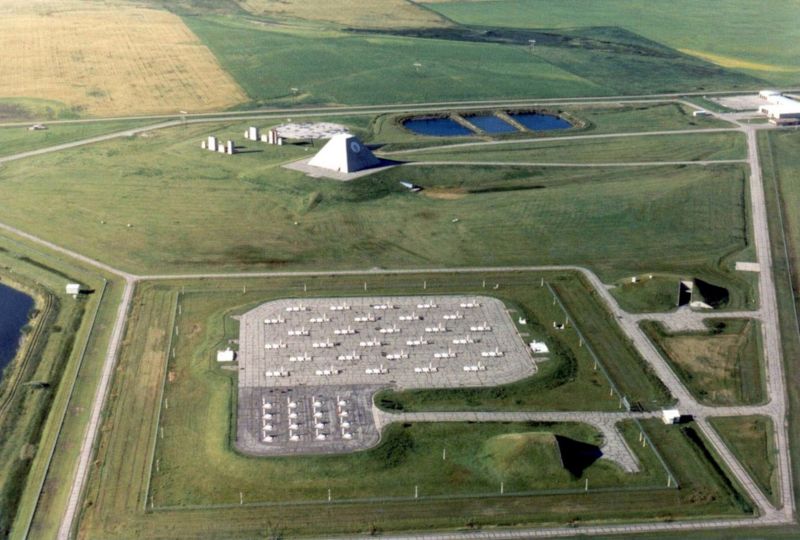
These efforts to build an ABM system were terminated by the 1972 Anti-Ballistic Missile Treaty (ABMT), which was half of the first Strategic Arms Limitation Treaty (SALT I). The ABMT limited each side to two land-based fixed ABM sites, with no more than 100 ABM weapons at each site. A 1974 revision of the treaty reduced the number of sites to one. The US deployed a Safeguard site in 1976, and shut it down a few months later. ABM defense went on the back burner.
* As a footnote, the nomenclature for missile defense can be confusing. Four basic classes can be defined:
Different sources may give different values for range. There are also "tactical ballistic missiles" and "theatre ballistic missiles" for battlefield use, with variations in definitions there as well, along with "strategic ballistic missiles", meaning IRBMs and ICBMs. Safeguard was intended to deal with strategic missiles.
BACK_TO_TOP* In the wake of the development of the Nike Ajax, in 1952 the US Army began development of a mobile SAM, under the designation of "SAM-A-18 (Homing All the Way Killer)". In 1954, the Army awarded development contracts to Raytheon -- for the missile itself -- and Northrop -- for the launcher, radar, and fire-control system. First launch of an XSAM-A-18 test item was in June 1956, with baseline development completed a year later. By that time, the Hawk had been redesignated "Guided Missile Aerial Intercept XM3". The M3 Hawk went into service with the Army in 1959, with the Marines following in 1960. It was redesignated "MIM-23A" in 1963, that being the designation used here. Incidentally, there were also inert training versions of the missile designated "MTM-23", and "MEM-23" versions with telemetry for flight test.
As originally introduced, the MIM-23A Hawk same was powered by an Aerojet General dual-thrust / boost-sustain solid-propellant rocket motor, being controlled in flight by four large triangular fins in a cruciform arrangement, with control surfaces behind the fins. It carried a 54-kilogram (119-pound) blast-fragmentation warhead, which was fitted with both impact and radar proximity fuzes.

The missile was directed by an X-band continuous wave (CW) radar system using semi-active radar homing (SARH), zeroing in on radar reflections from the target. It had an effective range of from 2 to 25 kilometers (1.25 to 2 miles). A Hawk battery had four radars:

The Hawk missiles were transported on and launched from M192 triple-missile towed launchers. In 1969, the Army fielded the M727 "self-propelled (SP) Hawk", with a triple launcher carried on a variant of the M548 general-purpose tracked vehicle.
_______________________________________________________________
RAYTHEON MIM-23A:
_______________________________________________________________
wingspan:
1.19 meters (3 feet 11 inches)
length:
5.08 meters (16 feet 8 inches)
diameter:
13 centimeters (14.5 inches)
launch weight:
584 kilograms (1,290 pounds)
maximum speed:
Mach 2.5
service ceiling:
13,700 meters (45,000 feet)
range:
25 kilometers (15 MI / 13 NMI)
_______________________________________________________________
In 1964, the US Army began a "Hawk Improvement Program (HIP)" to bring the missile system up to date -- one particularly significant improvement being incorporation of a digital processing unit into the fire control system, making it significantly smarter. All the system elements were updated: the PAR became the AN/MPQ-50, the CWAR became the AN/APQ-48, the HPI became the AM/MPQ-46, while the ROR became the AN/MPQ-51.
The missile itself was of course updated, becoming the "MIM-23B Improved Hawk (I-HAWK)." It featured a bigger 74-kilogram (163-pound) blast-fragmentation warhead, an improved and more compact guidance system, and a new M112 rocket motor. The missile's engagement envelope was stretched to 1.5 to 40 kilometers (5000 feet to 25 miles) at high altitude, or 2.5 to 20 kilometers (8200 feet to 12.4 miles) at low altitude, with a minimum engagement altitude of 60 meters (200 feet). The Improved Hawk entered service in 1971, and soon replaced older Hawks.
_______________________________________________________________
RAYTHEON MIM-23B HAWK:
_______________________________________________________________
wingspan:
1.19 meters (3 feet 11 inches)
length:
5.03 meters (16 feet 6 inches)
diameter:
13 centimeters (14.5 inches)
launch weight:
635 kilograms (1,400 pounds)
maximum speed:
Mach 2.5
service ceiling:
17,700 meters (58,000 feet)
range:
40 kilometers (25 MI / 22 NMI)
_______________________________________________________________
From 1977, leveraging off significant advances in electronics, the US Army began a multi-phase "Product Improvement Plan (PIP)", mostly to fix up the ground systems:
The MIM-23B Hawk missile itself was improved along a parallel track to the PIP upgrades:
The Hawk was exported to NATO countries, plus Bahrain, Egypt, Iran, Japan, Jordan, Kuwait, Romania, Morocco, Saudi Arabia, Singapore, South Korea, Sweden, Taiwan, and the UAE. A total of roughly 40,000 Hawks was built. The Hawk saw considerable combat use with Israel and Iran.
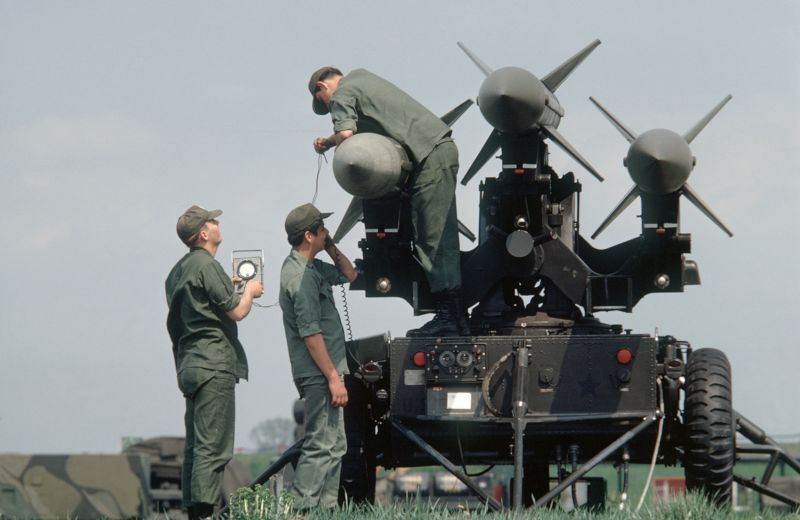
The US Army retired the Hawk from the mid-1990s, with the US Marines following early in the next decade. It has been retired by other NATO countries and US allies -- but obtained a new lease on life after the Russian invasion of Ukraine in early 2022, with retired Hawk launchers and missiles provided to Ukraine. They proved highly effective against Russian drones and cruise missiles.
Iran has not retired the Hawk, and in fact the Iranians manufacture it themselves. Their Hawk system is known as the "Mersad (Ambush)", with the missile itself being known as the "Shahin (Falcon)". It apparently has a number of refinements, possibly developed with Chinese cooperation.
The Iranians actually attempted to use the Hawk as an air-to-air missile (AAM). They had obtained a batch of Grumman F-14 Tomcat fighters from the US before the fall of the Shah, the F-14's main armament being the big "AIM-54 Phoenix" AAM. The AIM-54s gradually ceased to be functional, and so the Iranians decided to modify the Hawk -- which they produced under license -- to be carried by the F-14. The air-launched Hawks were designated "AIM-23", with three being carried.
That was a painfully clumsy scheme, so the Iranians simply cloned the Phoenix airframe, then crammed the Hawk seeker and rocket motor into it -- the Hawk and Phoenix are about the same size. The resulting "AIM-23B Fakkur-90" looked just like a Phoenix, except for ducts running up each side; an Iranian Tomcat could, of course, carry six of them. It appears to be in service now, but numbers built so far are unclear.
BACK_TO_TOP